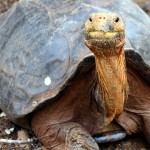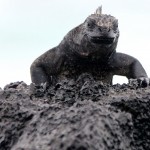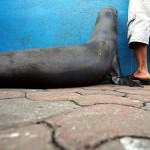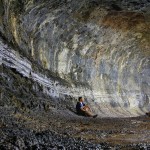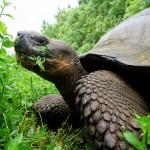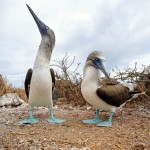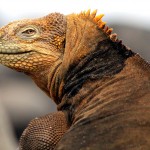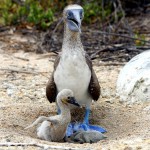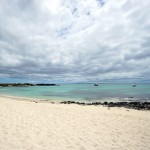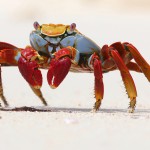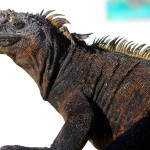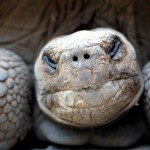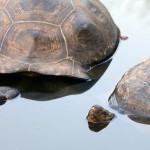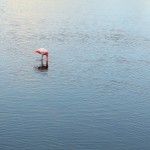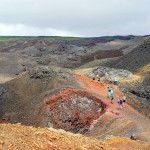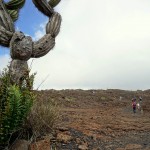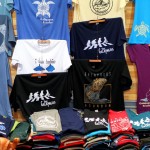Galapagos Islands
Darwin’s famed Natural Laboratory of Evolution
Tortoise Breeding Centre, Isla Isabela, Galapagos, Ecuador. July 19, 2015
Galapagos Islands
Even before departing the South American mainland for the Galapagos Islands, an archipelago of volcanic islands straddling the equator off the Ecuadorian mainland, you get a sense that the location is just a tad different, a break from the norm. And by the norm I mean anything you’ve ever likely to have experienced before. Access to Darwin’s natural laboratory of evolution, famed for its unrivaled array of wondrous endemic birds, mammals, reptiles & plants, requires not only the purchase of a TCT (Tarjeta de Control de Transito Turista, a Traffic Control Card) but also the payment of a US$100 Parque Nacional Galapagos conservation fee. This outlay coupled with baggage screening to ensure you’re not carrying, inadvertently of otherwise, any alien pests & seeds hints that you’re about to embark on a trip to somewhere rather special. And rather special it is.
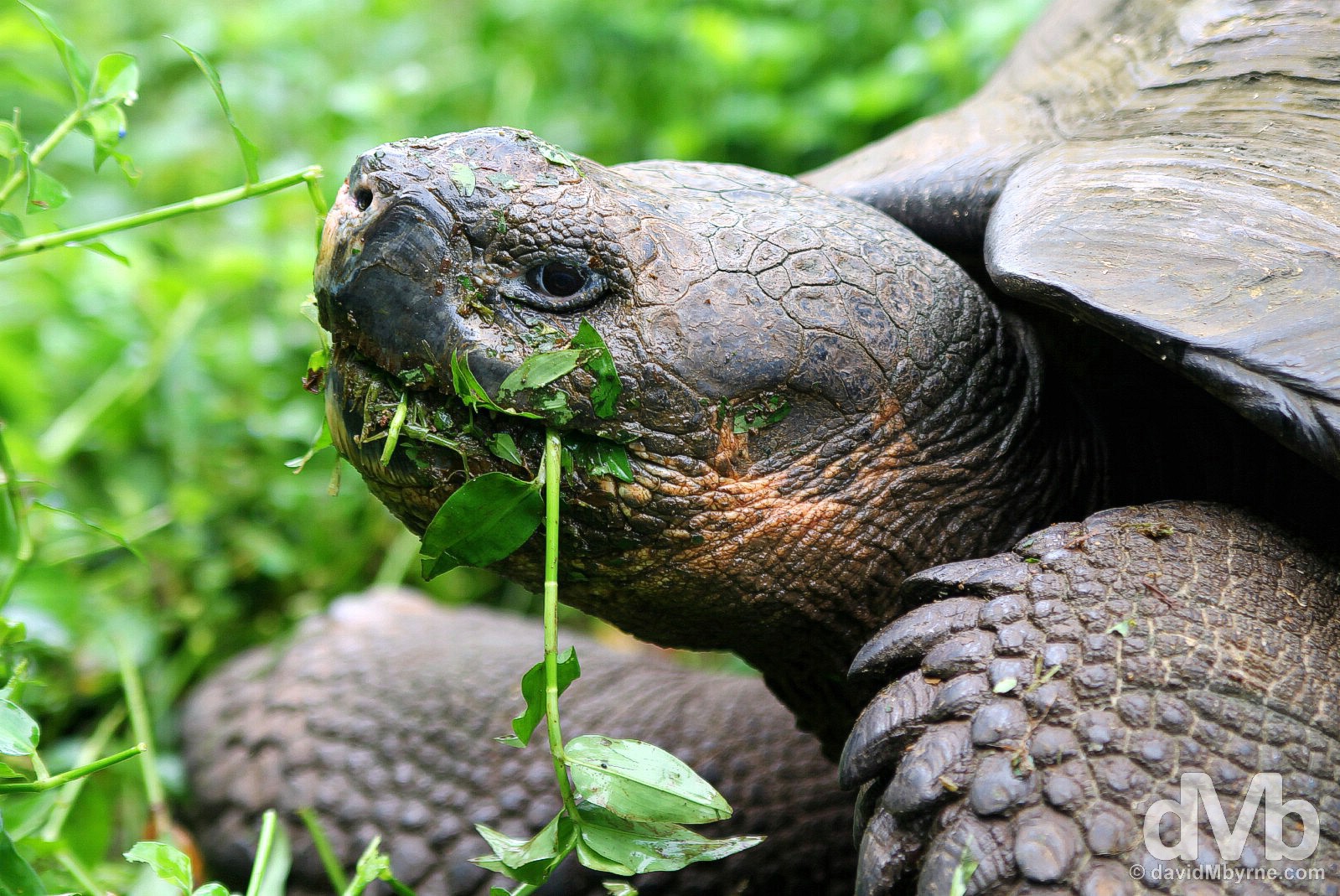
A Giant Tortoise feeding at Rancho Primicias on Isla Santa Cruz, Galapagos Islands, Ecuador. July 17, 2015.
Galapagos || History & Preservation
The name Galapagos first appeared on maps produced by Flemish cartographer Abraham Ortelius in 1574. Conventionally recognized as the creator of the first modern atlas, Ortelius named the islands based on accounts by earlier visitors to the archipelago who noted the ‘worthless’ nature of the volcanic land and the ‘many seal, turtles, iguanas, tortoises’ that lived there – Galapagos means tortoises in Spanish. The islands received few visitors until they became a favoured hangout for 17th & 18th century pirates who would stock up on giant tortoises; being able to survive for up to a year without food or water meant the timid & defenseless tortoises were prized provisions for long sea journeys. Whalers followed in the late 19th century, causing incalculable damage to not only Galapagos whale populations but also further decimating tortoise numbers – it is estimated that during the whaling era, when the giant tortoise was driven to extinction on some of the islands in the archipelago, around 200,000 tortoises were taken off Galapagos.
Ecuador annexed the archipelago in February 1832, three years before Darwin’s visit aboard the HMS Beagle, naming them the Archipelago of Ecuador. It took numerous attempts but eventually settlements were established on the inhospitable land. The inevitable happened in the 1940s with the construction of an airstrip and regular flights started in the late 1960s. Today the Galapagos Islands, billed as the world’s premier wildlife destination, attract some 200,000 visitors a year, three times as many as visited in 2000. Population numbers have also swelled, from 2,000 in the late 1950s to some 25,000 today, all of which puts great strain on the unique Galapagos environment despite seemingly strict controls on numbers visiting the designated tourist accessible sites dotted around the archipelago. Indeed, threats were so acute that in 2007 the UN declared the islands a World Heritage Site in Danger. Although the unwanted designation was removed in 2010 some still feel the unique biodiversity & matchless wildlife of Galapagos remain very much at risk.
– Ecuador Ministry of Tourism Touristic Information Guide to Galapagos
I spent 5+ days on Galapagos, independently visiting a few of the many islands to get a look at some of their unique inhabitants: I ogled at iconic, almost cartoonish like birds, the fabled giant tortoise, & demonic-looking iguanas; I cruised in calm waters to unique habitats & fought off seasickness bouncing between island settlements via small interisland water taxis; I explored & stumbled through pitch-dark, damp lava tubes; I walked & chased nimble crabs on picture-perfect beaches; and I trekked to volcanic craters & through wonderful volcanic topography. It was quite the ride. What follows is a day-by-day recap of my visit.
Read the entries as posted in chronological order or click here to jump directly to specific areas of the entry.
Day 1 – Puerto Ayora, Isla Santa Cruz (The Giant Tortoise & The Marine Iguana)
Day 2 – Isla Santa Cruz (Galapagos Diversity & Protection)
Day 3 – Isla Seymour Norte (The Blue-Footed Boobie, The Land Iguana, The Galapagos Sea Lion, & the Sally Lightfoot Crab)
Day 4 – Isla Isabela (Charles Darwin & His Theory of Evolution by Natural Selection)
Day 5 – Isla Isabela (Sierra Negra & Volcan Chico)
– Ecuador Ministry of Tourism
Galapagos Islands || The Gallery
- A Giant Tortoise at the Charles Darwin Research Station outside Puerto Ayora, Santa Cruz, Galapagos Islands, Ecuador. July 16, 2015.
- A Marine Iguana outside Puerto Ayora on Isla Santa Cruz, Galapagos, Ecuador. July 16, 2015.
- Feeding time in Pelican Bay, Puerto Ayora, Isla Santa Cruz, Galapagos Islands, Ecuador. July 16, 2015.
- Inside the Tunel del Amor outside the village of Bellavista, Isla Santa Cruz, Galapagos Islands, Ecuador. July 17, 2015.
- A Giant Tortoise feeding. Rancho Primicias, Isla Santa Cruz, Galapagos, Ecuador. July 17, 2015.
- A Giant Tortoise feeding at Rancho Primicias, Isla Santa Cruz, Galapagos, Ecuador. July 17, 2015.
- A pair of blue-footed boobies on Isla Seymour Norte, Galapagos, Ecuador. July 18, 2015.
- A Land Iguana on Isla Seymour Norte, Galapagos, Ecuador. July 18, 2015.
- A blue-footed boobie & chicks nesting on Isla Seymour Norte, Galapagos, Ecuador. July 18, 2015.
- Sea Lions on Isla Seymour Norte, Galapagos Islands, Ecuador. July 18, 2015.
- Playa Las Bachas, Isla Santa Cruz, Galapagos Islands, Ecuador. July 18, 2015.
- Playa Las Bachas, Isla Santa Cruz, Galapagos Islands, Ecuador. July 18, 2015.
- Playa Las Bachas, Isla Santa Cruz, Galapagos Islands, Ecuador. July 18, 2015.
- A Sally Lightfoot Crab on Playa Las Bachas, Isla Santa Cruz, Galapagos, Ecuador. July 18, 2015.
- A Marine Iguana recharging the batteries by basking in the sun on Playa de Amor, Isla Isabela, Galapagos, Ecuador. July 19, 2015.
- A resident tortoise in the Tortoise Breeding Centre on Isla Isabela, Galapagos, Ecuador. July 19, 2015.
- Giant Tortoises in a pool in the Tortoise Breeding Centre on Isla Isabela, Galapagos, Ecuador. July 19, 2015.
- A Flamingo in a pond on Isla Isabela, Galapagos, Ecuador. July 19, 2015.
- The volcanic landscape of Volcan Chico on Isla Isabela, Galapagos, Ecuador. July 20, 2015.
- Volcanic topography on Volcan Chico, Isla Isabela, Galapagos Islands, Ecuador. July 20, 2015.
- Apparel on sale in Seymour Airport, Isla Baltra, Galapagos Islands, Ecuador. July 21, 2015.
Galapagos Islands Highlights Location Map
Day One
Date || July 16, 2015
Location || Puerto Ayora, Isla Santa Cruz, Galapagos, Ecuador ( )
)
A parched, barren land. That was my first impression of the famed Galapagos Islands after sighting the uninviting landscape surrounding Seymour Airport on Isla Baltra. ‘Is this it?’ I thought, as I recalled also being underwhelmed when first laying eyes on the landscape of another volcanic wonderland some years earlier, that of Iceland – whereas Iceland was barren, black & damp, Galapagos was barren, yellow & dry. Things got a lot easier on the eye – and lush, a lot more lush – once I’d crossed the Canal de Itabaca, the narrow stretch of water separating Baltra from Isla Santa Cruz, a circular island some 1000 km² in size and the most populous & visited of all the islands in the Galapagos archipelago. Within a few minutes of arrival I’d already sampled how vastly different two of the neighbouring Galapagos Islands were. No wildlife yet, save for a few seabirds, frigate birds as pointed out by Pat, my good friend who’d accompanied me to the islands. I guess he’s more of a ornithologist than I am. After boarding the local minibus & traversing conical Santa Cruz – north to south, up one side, down the other – & finding a bed in Puerto Ayora, the tourist hub of the Galapagos and home to the majority of its population, it was time to set out to meet some of the famous natives, the reason we had ventured here to these wondrous little islands in the first place.
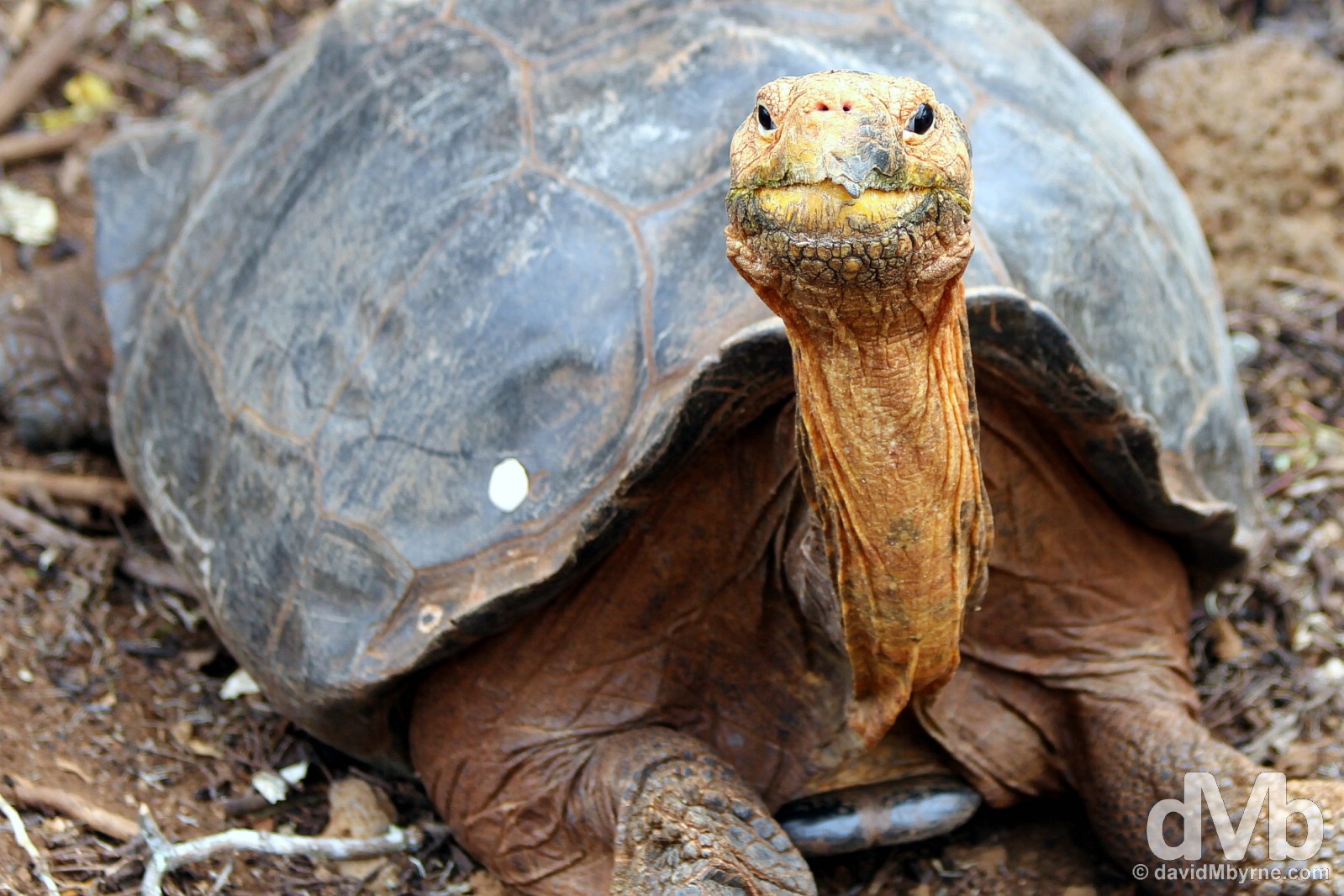
A Giant Tortoise at the Charles Darwin Research Station outside Puerto Ayora, Santa Cruz, Galapagos Islands, Ecuador. July 16, 2015 || My first port of call in Galapagos was always going to be the Charles Darwin Research Station, a short walk outside Puerto Ayora. Although primarily a science & conservation facility, it’s a popular stop on the Galapagos tourist circuit thanks to its tortoise-rearing pens, predator-proof enclosures housing batches of miniature giant tortoises according to age, and the tortoise corals, housing fully grown tortoises like the one seen here, the very first of the emblematic tortoises I saw in Galapagos. It was truly amazing to be here in person having viewed videos of the site for many years prior. Until his death in June 2012, this was the home of Lonesome George, the last surviving tortoise of the Pinta island subspecies of Galapagos giant tortoise, a subspecies thought to have already been extinct prior to the discovery of George in 1976. Considered by many to be the rarest animal on the planet, when he died peacefully in his sleep he was estimated to be about 100 years old. (Check out this short video of Lonesome George captured prior to his death, obviously.)
The Giant Tortoise
The hoary Giant Tortoise, the emblems of Galapagos and the origin of the archipelagos name, spread out, helped by marine currents, from the youngest of the islands to the east of the Galapagos archipelago, Isla Espanola & Isla San Cristobal, and today are found on 4 more of the Galapagos islands (6 total) – Isla Isabela, Isla Santiago, Isla Pinzon & Isla Santa Cruz. Weighting up to 250 kilograms they are, not surprisingly, the world’s largest tortoises. Needless to say, they have evolved well (Galapagos = evolution) to the varying environments of the different islands they inhabit; dome-shaped tortoises with shorter necks live on larger islands with dense & ground-level vegetation whereas saddleback tortoises with longer necks, like the tortoise seen in the above picture, inhabit lower islands with less vegetation, their longer neck allowing them to feed from higher bushes & cactus. While there were once 14 subspecies and estimates of more than 250,000 tortoises roaming the islands, today tortoise populations have declined by more than 90% because of invasive species, habitat loss, & overexploitation, especially during the whaling era of the nineteenth century when three subspecies became extinct – the death of Lonesome George in 2014 means there are now 10 remaining known subspecies of giant tortoise. All Galapagos tortoises are particularly vulnerable to extinction for many reasons – their population are relatively small, they are isolated, they are less genetically variable, & also because they lack natural defenses against introduced predators & competitors. Now fully protected, threats to present-day giant tortoises are thankfully few, meaning they can happily live for well over 100 years making them one of the longest-lived vertebrates. It seems nothing rushes the deliberate, lumbering giant tortoise.
Moving on from the tortoises of the Charles Darwin Research Station, it was time to take a walk among the volcanic rocks overlooking the shore outside Puerto Ayora to say hi to another unique Galapagos inhabitant, the Marine Iguana.
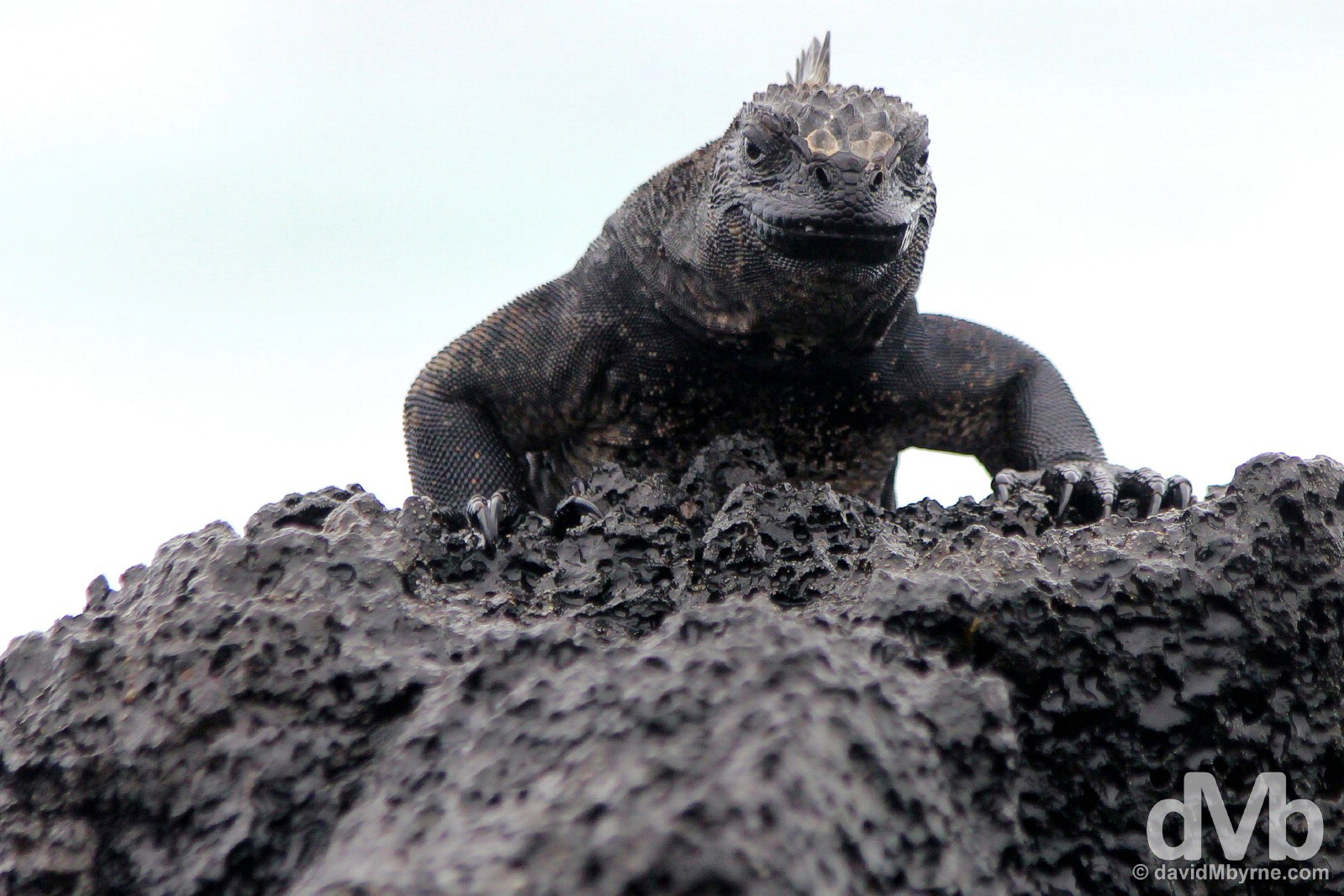
A Marine Iguana on the rocks outside Puerto Ayora on Isla Santa Cruz, Galapagos, Ecuador. July 16, 2015.
Marine Iguana
Endemic of the Galapagos and found all over the islands, the demonic-looking Marine Iguana are unique among modern lizards in having the ability to forage in the sea. They feed on seaweed and algae, can dive for up to 12 metres and have the ability to stay submerged for up to an hour. Lethargic and somewhat difficult to see set against jet-black lava rocks, they are also dead silent except for when they sneeze excess salt from their front nostrils, an ability they developed as they evolved to marine life on Galapagos. A unique marine reptile it may be but still a reptile nonetheless – being cold-blooded means, & like all reptiles, it needs to recover energy by basking motionless in the sun for long periods of time, something that makes them rather easy to photograph. Just don’t get too close. You might scare them off or, even worse, get a spray of salt for your troubles.
Puerto Ayora
Inhabited since the early 20th century and officially settled in the 1920s by hardy Norwegians, Puerto Ayora today home to the majority of its the archipelago’s 25,000 population; it has expanded rapidly since the 1970s when it had a population of only a few hundred.
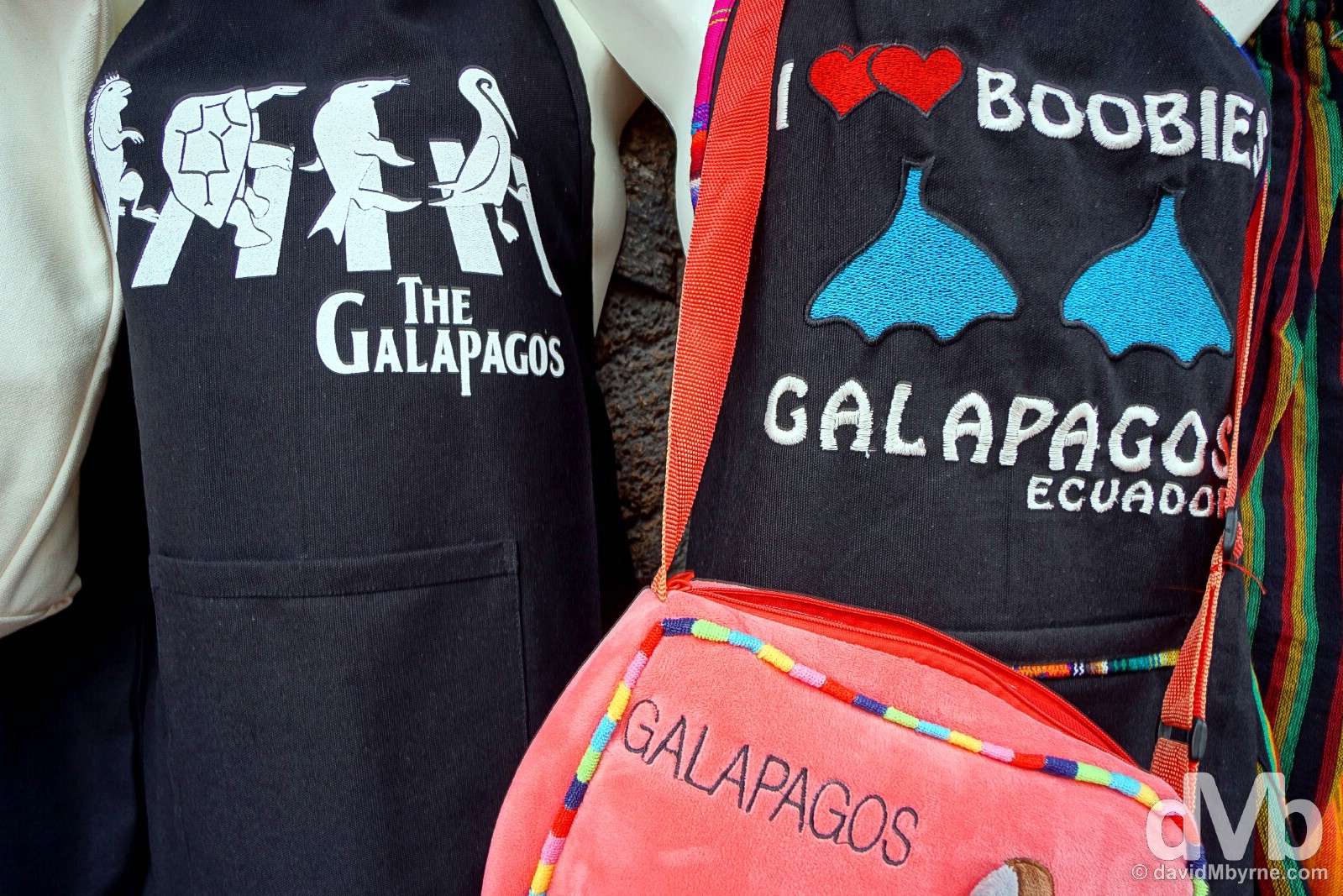
I Love Boobies. Indeed. For sale in Puerto Ayora on Isla Santa Cruz, Galapagos, Ecuador. July 16, 2015 || Although it’s the tourism hub of the Galapagos, a settlement awash with tourists-related shops & services and myriad seafood restaurants, bars and cafes, Puerto Ayora is still a relaxed place & the perfect base for independent, expensive cruise-shunning travellers to investigate and organise excursions elsewhere in Galapagos.
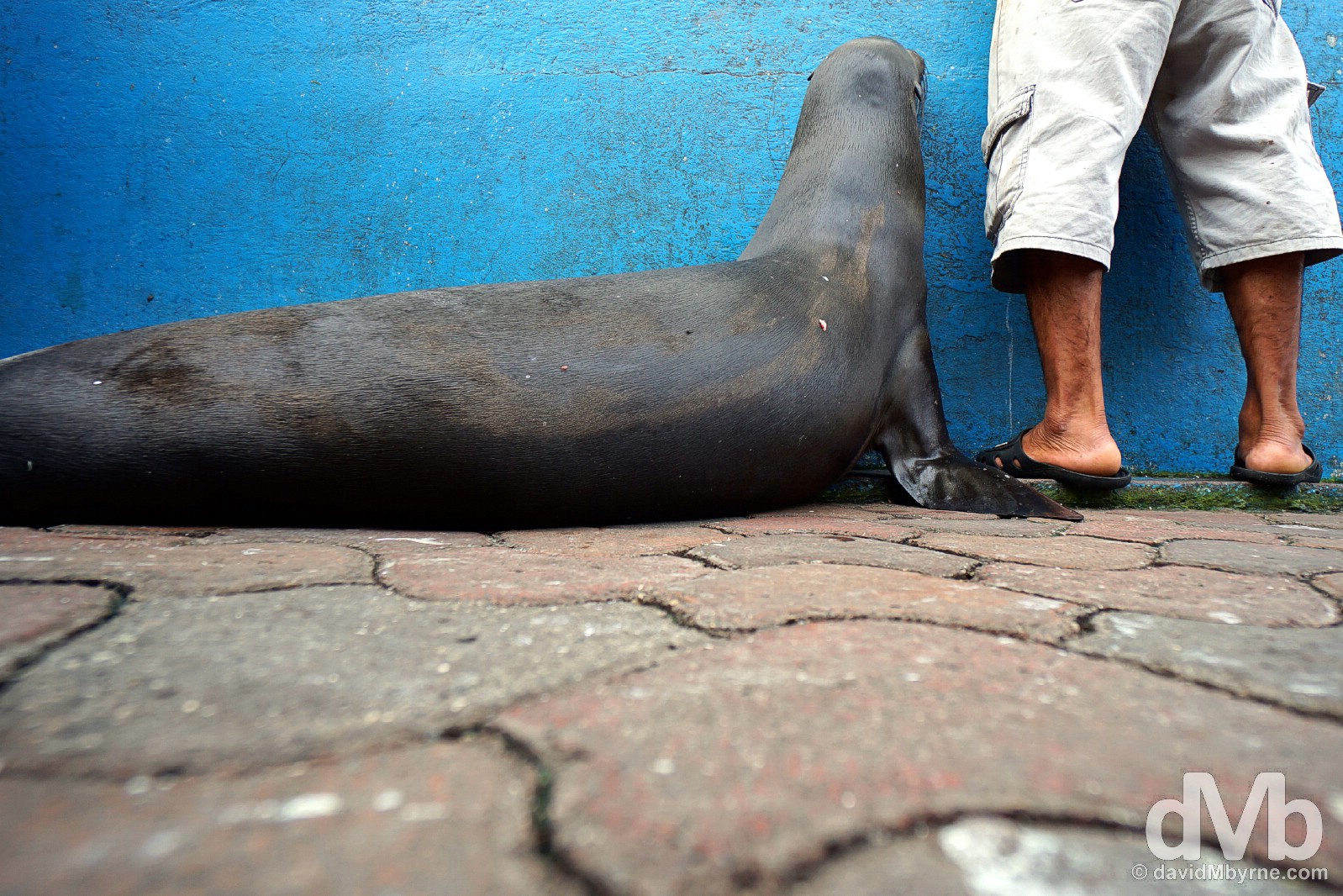
Feeding time in Pelican Bay, Puerto Ayora, Isla Santa Cruz, Galapagos Islands, Ecuador. July 16, 2015 || There’s always a buzz down at Puerto Ayora’s small Pelican Bay, a very popular outdoor seafood restaurant at night, when the local fisherman haul their catch ashore and sort through it. Hungry pelicans flap about, their massive wingspan and swooping manoeuvers a hazard for the many camera-toting tourists the spectacle attracts, while opportunistic sea lions wait patiently for scraps. Both the pelicans and the sea lions seem to be treated fairly, the fishermen just as adept at divvying out the spoils as they are at gutting their catch.
Day Two
Date || July 17, 2015
Location || Puerto Ayora, Isla Santa Cruz, Galapagos, Ecuador ( )
)
Day two in Galapagos, the first full day, was a damp one. It was overcast and while the rain held off for the most part there was a sense of heavy tropical moistness in the air, not to mention an abundance of greenery surrounding us as Pat and I broke out from Puerto Ayora & explored some of the accessible highlights of Isla Santa Cruz. Using a combination of almost non-existent public transport, accommodating bus drivers driving empty buses, private are-you-going-our-way? transport and our own legs, we eventually found what we went looking for, our transportation exploits today leaving us in no doubt that, and while it is possible to do Galapagos independently, it’s gotta be so much easier, albeit so much more expensive, as part of a tour.
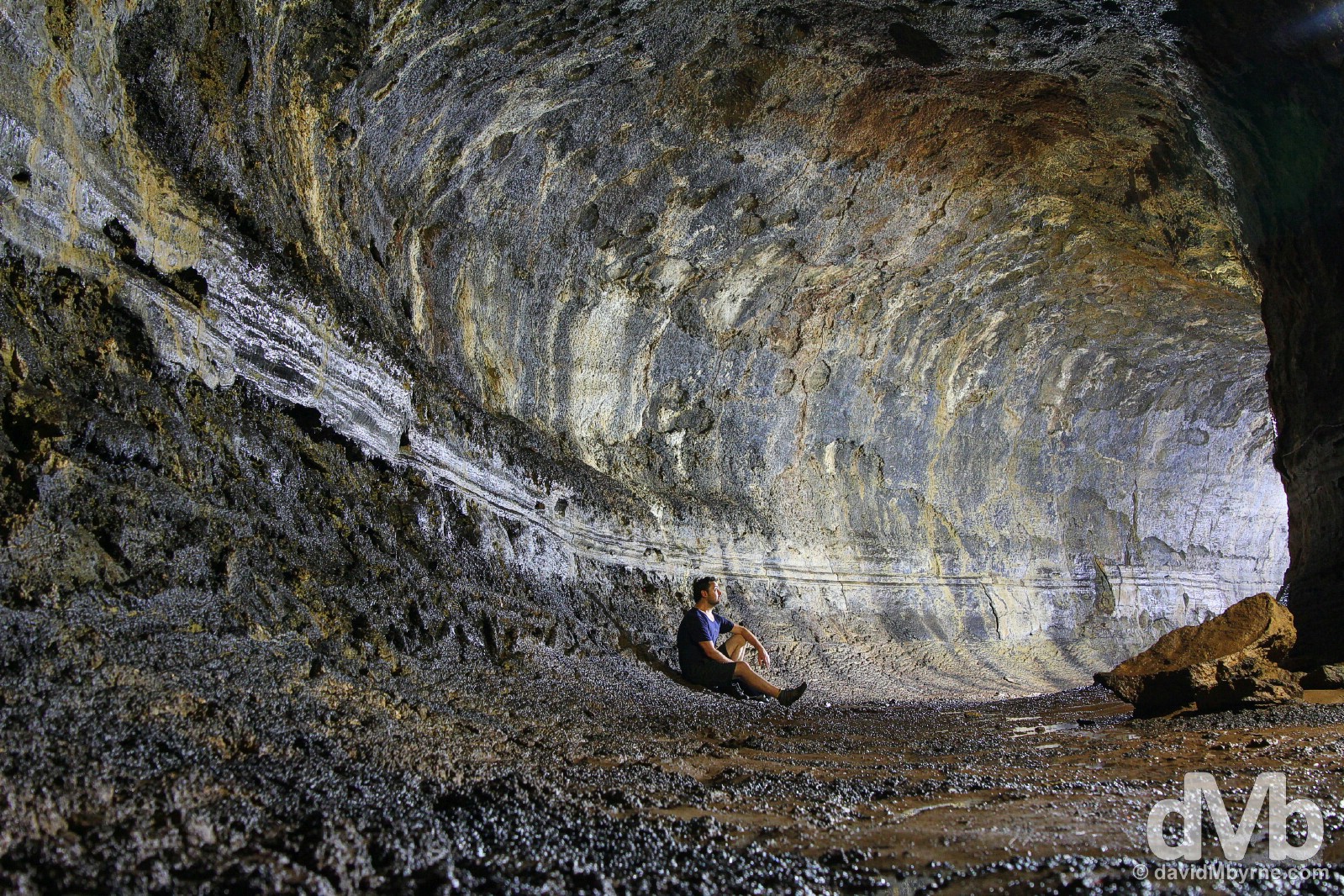
Inside the Tunel del Amor outside the village of Bellavista, Isla Santa Cruz, Galapagos Islands, Ecuador. July 17, 2015 ||The Galapagos Islands isn’t just about unique wildlife. Volcanic in origin, lava tubes perforate Santa Cruz, the most accessible of them being the 2 kilometre-long Tunel del Amor outside the village of Bellavista not too far from Puerto Ayora & easily reached by public transport. Formed when lava flows subside after cooler outer parts of the flow had hardened into thick rock walls, most lava tubes on Santa Cruz can be visited independently, i.e. without a National Park guide, because they reside on private land – to visit the majority of Galapagos sites requires the services of a guide. Had we been visiting in the company of a guide then we’ve no doubt that the guide would have known about the light switch near the tube’s entrance. We didn’t so we stumbled around down here in pitch darkness with only the lights of our smartphones allowing us to see anything at all. That was until such time as a guide leading other tourists turned up to spoil the darkness. When the lights were turned on, and once the initial fright of the cave being illuminated had subsided, I gave up trying to photograph my environs by smartphone light alone. With the lights on, it was a much simpler undertaking capturing this 6-second exposure of Pat, a lava tube virgin until this day (I’d visited similar tubes on the Big Island of Hawaii & on South Korea’s Jeju Island)
Galapagos || Diversity & Protection
Mainly because of its location & geographical isolation, the Galapagos archipelago is one of the most complex, diverse & unique oceanic archipelagos in the world. From giant tortoises to tiny finches and from cold-water penguins to tropical coral, the Galapagos archipelago boasts an extraordinary range of distinctive habitats, vegetative zones and plant and animal species. There exists 7,214 identified species in the Galapagos, over 30% of which are endemic/native to the islands. Researchers flock to this isolated archipelago because of its ecosystem simplicity and few extinctions of unique species found nowhere else on earth. This makes Galapagos one of the best places to study evolution as an ongoing process in a natural environment. A truly unique environment, not only is 97% of Galapagos terra firma protected in the form of the Parque Nacional Galapagos (established in 1959) but 133,000 km² of ocean is also protected as part of the Reserva Marina de Galapagos (established in 1986). UNESCO have done their bit too, as both the terrestrial and marine areas of Galapagos have been granted World Heritage status – Parque Nacional Galapagos was inscribed on the list in 1978, one of the first locations to be awarded protective UNESCO status.
– UNESCO commenting on Galápagos Islands
Rancho Primicias To The Rescue
After emerging from the lave tube of subterranean Santa Cruz, blagging a ride in an empty bus, & a stern walk, we arrived, by accident, at Rancho Primicias in the southwest of the island. We were looking for somewhere called the El Chato Tortoise Reserve, a well-know location on the island and somewhere billed as among the best places in Galapagos to see giant tortoises in their natural habitat. We did find El Chato – so said the sign – but the wooded area we found ourselves in was so waterlogged that we were unable to explore if fully. Escaping the El Chato mire, we somehow ended up among the giant tortoises of the nearby Rancho Primicias, a private reserve that provided what we were hoping El Chato would have – an unforgettable, up close & personal encounter with the Galapagos giant tortoise, the highlight of my trip to the Galapagos Islands.

A Giant Tortoise feeding. Rancho Primicias, Isla Santa Cruz, Galapagos, Ecuador. July 17, 2015 || Chances are when you encounter a giant tortoise it’ll be eating. Strict vegetarians, they eat more than 50 plant species and will eat heartily when food is abundant, as it is here at Rancho Primicias.
– Rough Guide to Ecuador & Galapagos
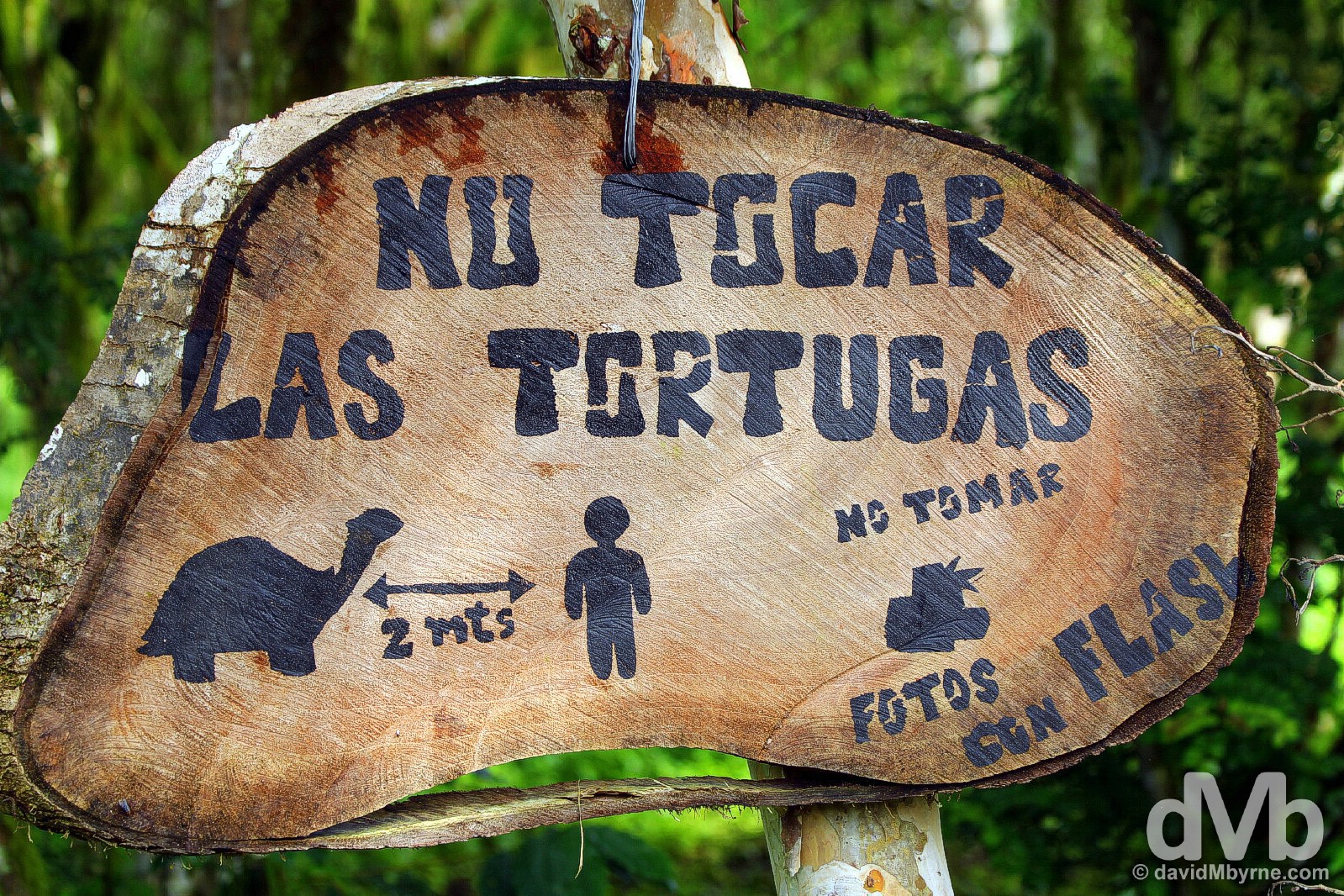
A sign at Rancho Primicias on Isla Santa Cruz, Galapagos, Ecuador. July 17, 2015 || The rules when in the presence of the tortoises (las tortugas) are simple. Keep a distance of at least 2 metres, don’t touch (tocar), & don’t take (tomar) pictures with flash. Breaking these rules will more than likely agitate a giant tortoise. While virtually silent apart from when they mate, a ritual which can last for hours, an agitated tortoise will retreat into its shell and make a sharp hissing sound by blowing air out of its nostrils. Rules (and zoom lenses) aside, the urge to get as close as possible to the docile creatures when in their presence is strong.
Day Three
Date || July 18, 2015
Location || Puerto Ayora, Isla Santa Cruz, Galapagos, Ecuador ( )
)
There are only 116 designated visitor sites dotted around the Galapagos archipelago: 54 land-based sites and 62 scuba or snorkelling sites. As already stated, only some of these site can be visited independently without an accompanying National Park-licensed guide. The majority of them, and in a bid to limit the impact of visitors on the fragile environment, require a guide and small group visits are limited to between 2 and 4-hour shifts. Day three on Galapagos was all about signing up for one of the many day trips to a nearby island in a bid to visit sites otherwise only accessible as part of an expensive multi-day cruise. Options aplenty and having done our homework we chose to embark on a day trip to Isla Seymour Norte, a small, low & flat island formed by the up-lifting of submarine volcanic lava. A largely barren island of low-lying bush scrub & cacti, the island is renowned as one of the best places in Galapagos to view the blue-footed boobie & the magnificent frigatebird (that’s the actual species name & not me engaging in hyperbole by adding an unnecessary adjective). So that’s why we chose Isla Seymour Norte. Because we wanted to see boobies, the darling of all Galapagos birds. Anything else was going to be a bonus.
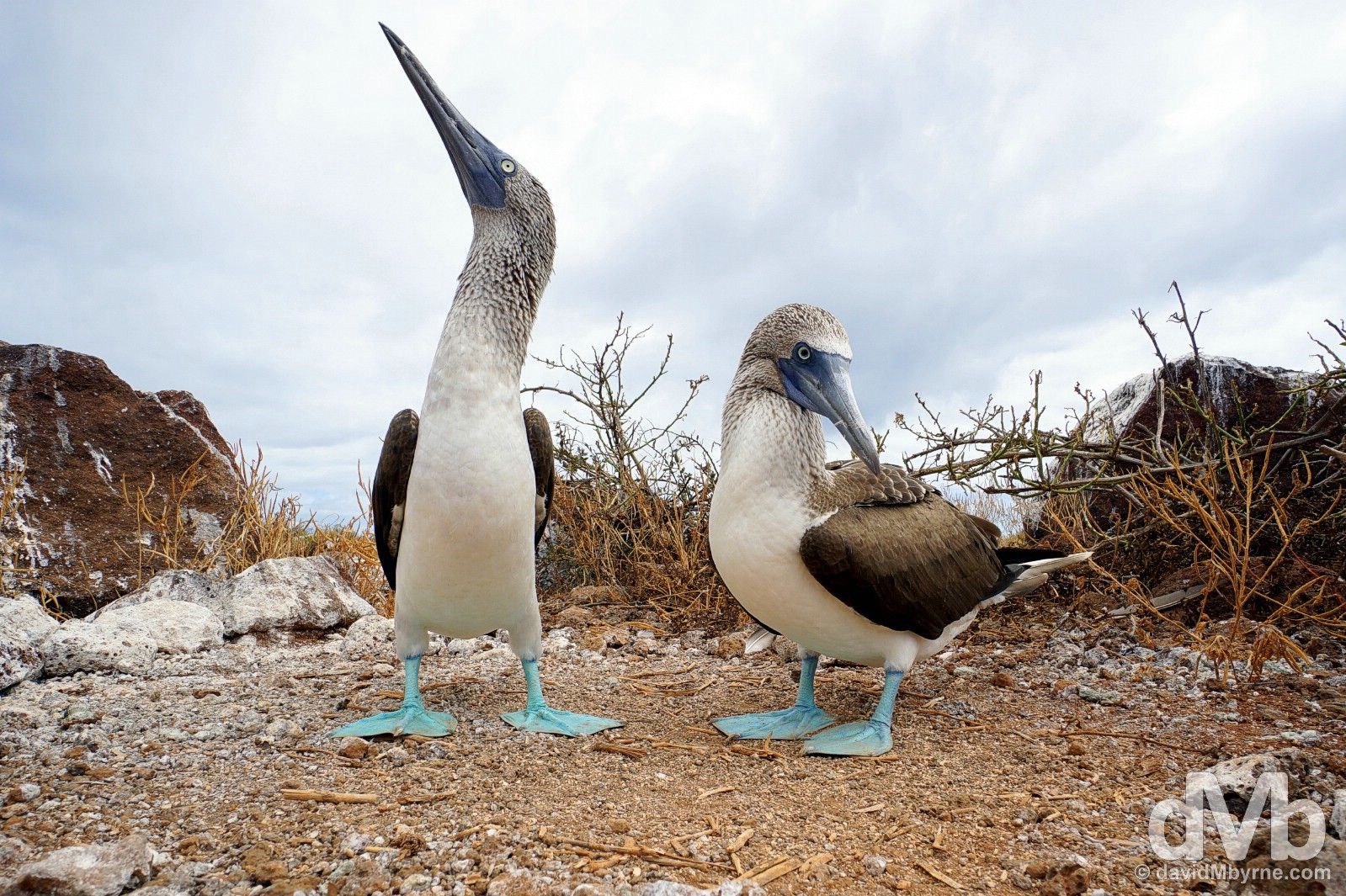
A pair of blue-footed boobies on Isla Seymour Norte, Galapagos, Ecuador. July 18, 2015.
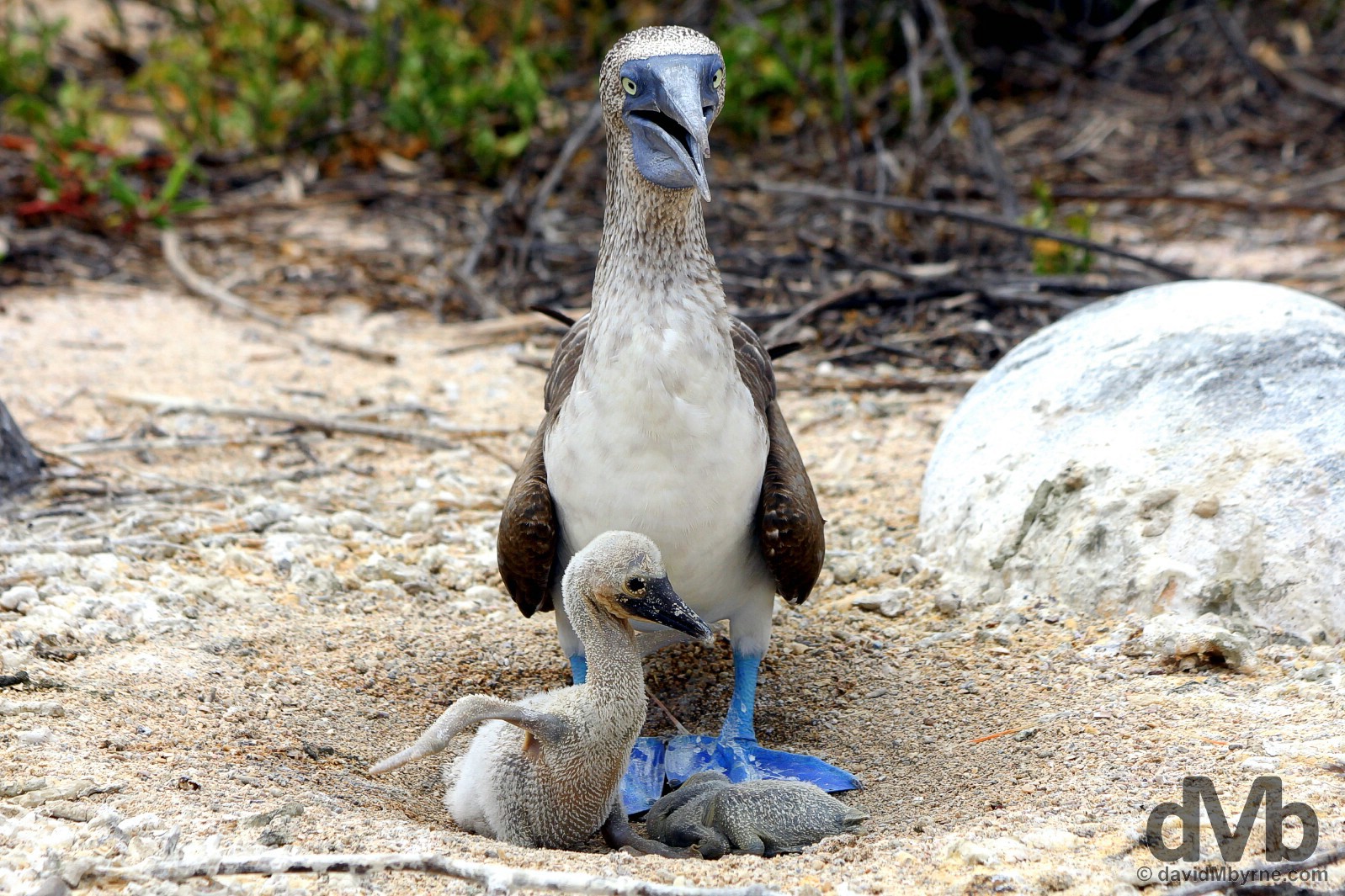
A blue-footed boobie & chicks nesting on Isla Seymour Norte, Galapagos, Ecuador. July 18, 2015
Blue-Footed Boobie
I’m not much of a fan of warm-blooded egg-laying vertebrates but I do love boobies (who doesn’t?). The small tropical gannet, with its distinctively bright feet (they come in blue & red varieties), the booby is the darling of all Galapagos birds – ‘I Love Boobies’ t-shirts are one of the must-have Galapagos souvenirs. Instantly likable not only because of their coloured feet but also because of their somewhat comedic waddle & their wonderful courtship display of sky-pointing & high-stepping to show off the blueness of their feet, their name is thought to come from the Spanish word bobo, meaning ‘fool’, a reference to their relaxed attitude to being caught – like all Galapagos fauna, the boobies have no fear of humans having evolved in an environment free of predators. The female can lay up to three eggs, although two is more common, which she incubates with her feet. If food is scarce, the first-born hatching will, and as seems to have happened in the above picture, tuck into its less fortunate sibling to ensure at least one survives.

A Land Iguana on Isla Seymour Norte, Galapagos, Ecuador. July 18, 2015.
Land Iguana
Galapagos is home to three endemic species of land iguana which exist nowhere else on earth, one of which, a remarkable pink iguana, was only discovered high on the remote summit of a volcano on Isla Isabela (see below) as recently as 2009. Larger than marine iguanas, land iguanas are among the largest iguanas in the world – adult males can grow to over half a metre in length and can weigh over 13 kilograms. Although primarily herbivores feeding on cactus pads & fruits, they are opportunistic feeders and will try anything at least once. They live on average for 40+ years, sometimes hitting 60 years of age, but are extremely vulnerable to human activity and any natural predators, competitors or loss of habitat can rapidly cause their extinction. Animals introduced by early visitors and colonists pushed some land iguana populations to the brink of extinction. Scientists estimate that tens of thousands of land iguanas once roamed Santa Cruz island alone; by 1976 fewer than 100 remained. Extinct on Isla Santiago, they were almost finished off on Isla Baltra as a result of airstrip-related World War II activity, though fortunately some had been moved here to Isla Seymour Norte previous to this and have since been reintroduced to their home island. It is estimated that of the about 600 land iguanas found on Isla Seymour Norte, two-thirds of them have been repatriated with the rest having hatched naturally.
Our time on Isla Seymour Norte was at an end, but not before we got something of a send-off.

Sea Lions on Isla Seymour Norte, Galapagos Islands, Ecuador. July 18, 2015 || Our farewell party leaving Isla Seymour Norte, two Galapagos Sea Lions resting on the lava ledges at the edge of the island. A relative of the larger Californian sea lion, the graceful, inquisitive & friendly animals are a Galapagos favourite, assuming they are doing something more than simply lounging in the sun as they are here.
There wasn’t much cruising done – distances were small – but what cruising that was done on this day, a gorgeously sunny day in Galapagos waters, was enjoyable and relaxing.
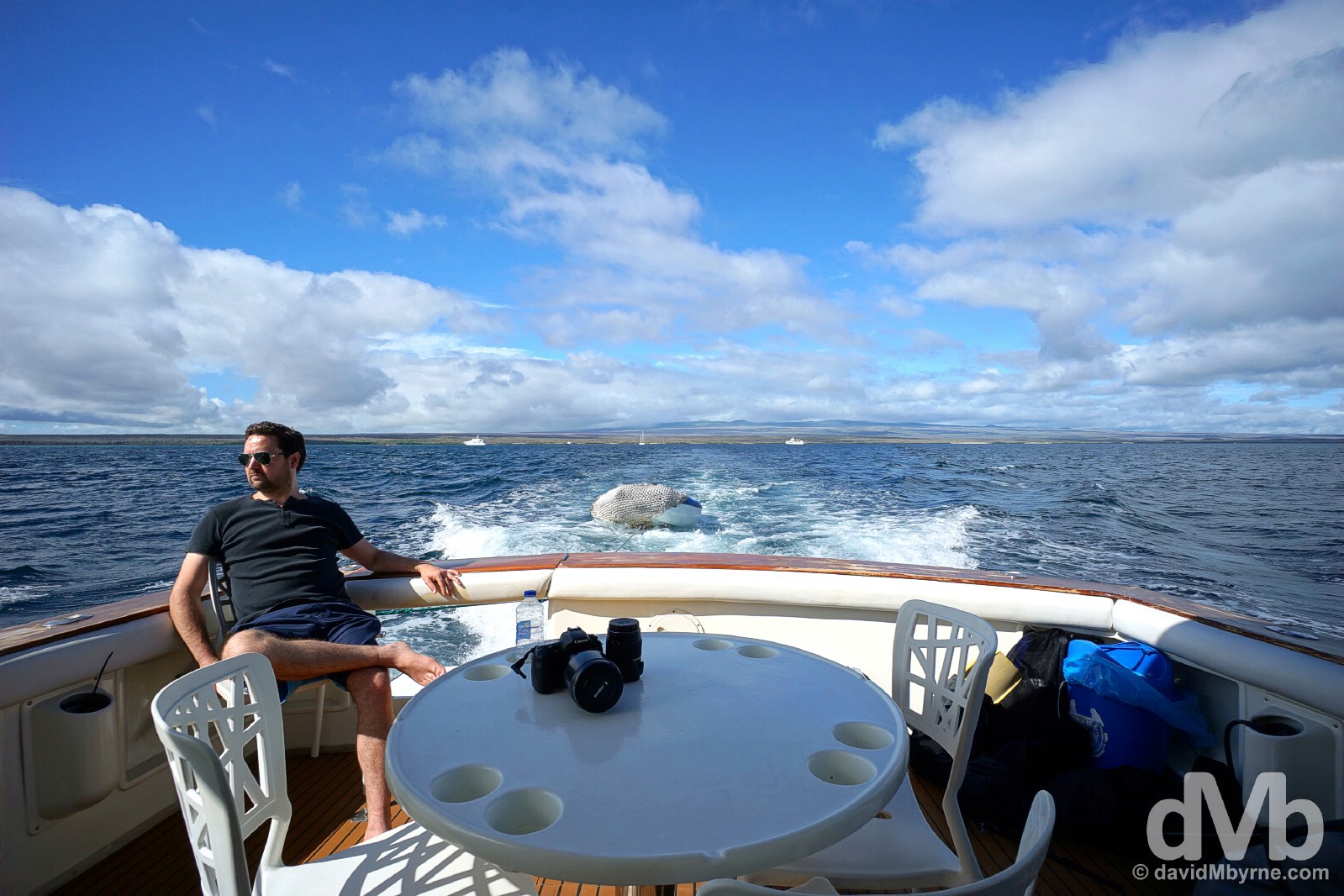
On board the Altamar en route from Isla Seymour Norte to Playa Las Bachas on Isla Santa Cruz. Galapagos, Ecuador. July 18, 2015 || Our transport on this day was the Altamar, a pleasant and comfortable cruiser for a pleasant & comfortable cruise in the waters of Galapagos.
Playa Las Bachas
Our last stop on Galapagos day three was the stunning secluded stretch of sand that is Playa Las Bachas. And while this beach is located on the north coast of Isla Santa Cruz, the most populous & developed of all Galapagos islands, it is still only accessible via boat.
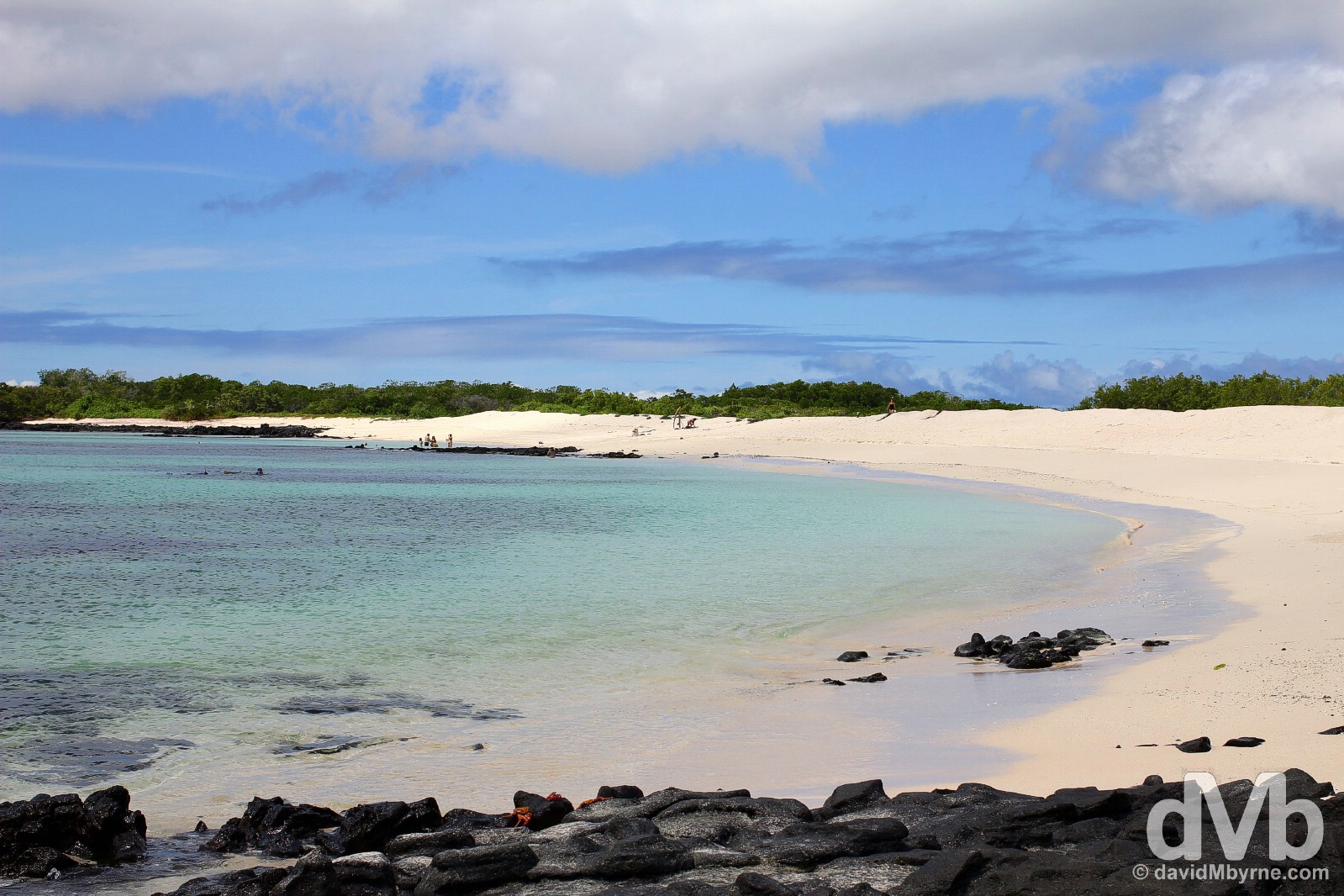
Playa Las Bachas, Isla Santa Cruz, Galapagos Islands, Ecuador. July 18, 2015.
A few other captures from the gorgeous Playa Las Bachas.
- Playa Las Bachas, Isla Santa Cruz, Galapagos Islands, Ecuador. July 18, 2015.
- Playa Las Bachas, Isla Santa Cruz, Galapagos Islands, Ecuador. July 18, 2015.
I passed on the option to snorkel in the clear waters off the beach, opting instead to enjoy the flamingos wading in a nearby saltwater lagoon & to play a few games with the Sally Lightfoot crabs who call this beach home.
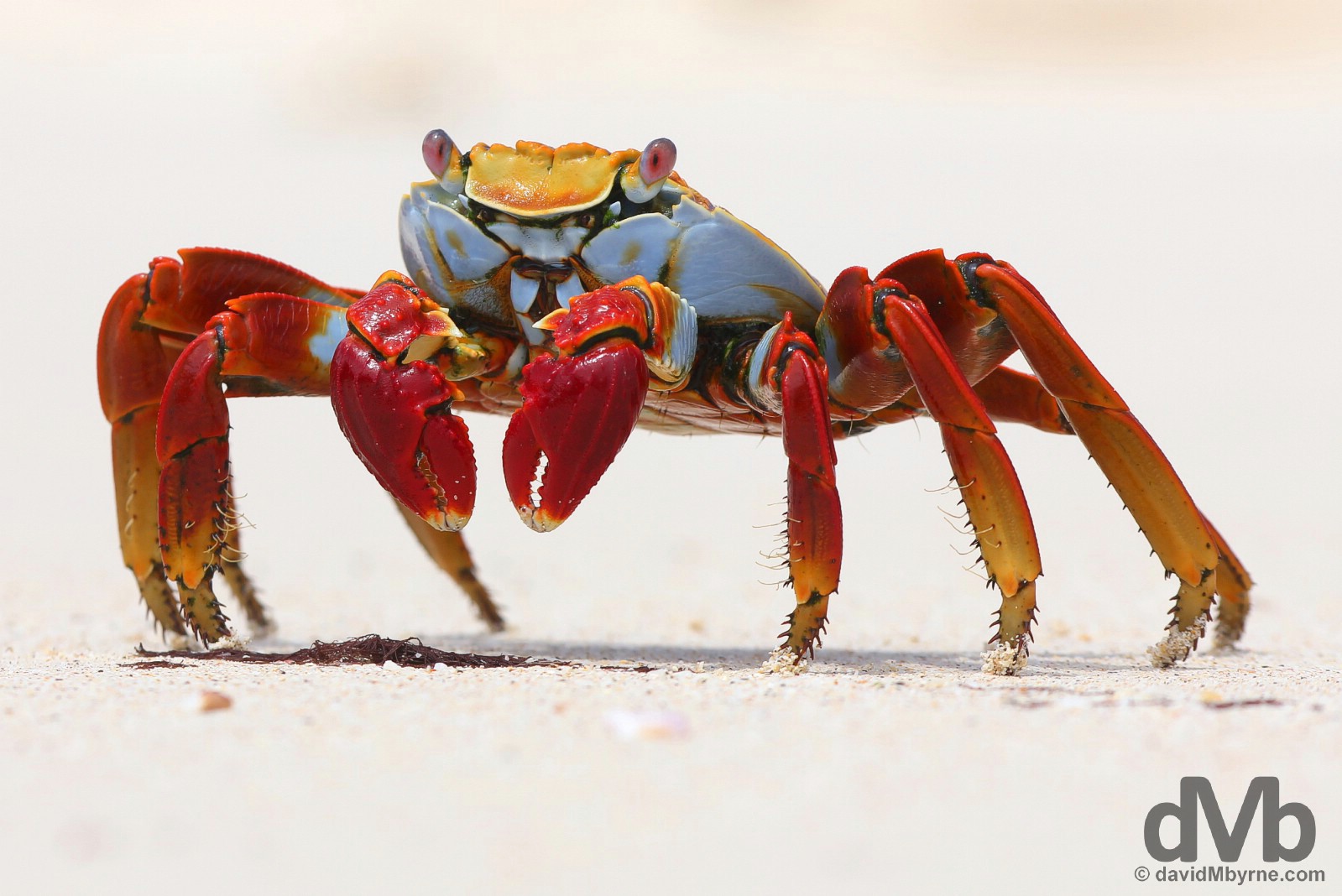
A Sally Lightfoot Crab on Playa Las Bachas, Isla Santa Cruz, Galapagos, Ecuador. July 18, 2015 || The distinctive & brilliantly-coloured Sally Lightfoot crab is found in intertidal areas, particularly rocky shorelines, scavenging for scraps and spooning up pieces of algae on specially adapted pincers. A skittish, very quick-moving and agile crab, they are also somewhat curious and will investigate if a subject stays still. I had a lot of fun with this Lightfoot, the unexpected highlight of the time I spent on one of the most gorgeous stretches of sand I have ever visited. Playing an enjoyable game of Your Move, I managed to get close enough to the crab to capture this picture before it threw in the towel and scattered away to the refuge of the rocks. I win.
Seemingly I’m not the only one to have enjoyed their interaction with the Sally Lightfoot crab.
– John Steinbeck (1902-1968), American Author, commenting on the Sally Lightfoot crab
Day Four
Date || July 19, 2015
Location || Puerto Villamil, Isla Isabela, Galapagos, Ecuador ( )
)
It took all I could muster to not succumb to the choppy waters of the Pacific Ocean early on this day as we took the small 6 a.m. interisland ferry between Puerto Ayora on Isla Santa Cruz and Puerto Villamil on Isla Isabala, a distance of some 80 kilometres. Staring at the moving horizon out the back of the ferry helped stave off the desire to puke somewhat, as did taking solace in the fact that I wasn’t at the rear of the craft getting royally soaked as we bounced through wave after wave after wave. It wasn’t a long crossing – a little over 2 hours – but it was a testing one, a testing start to Galapagos day 4.
Isla Isabela & Puerto Villamil
Straddling the equator, 4,600 km² Isla Isabela, named after Queen Isabella of Spain, is the largest of the Galapagos islands, claiming almost 60% – 58% to be precise – of all Galapagos terra firma. Estimated to be a juvenile 1 million years old, it’s one of the youngest of the islands in the Galapagos archipelago and one that’s still growing. The 100 kilometre-long seahorse-shaped island is made up of a string of 6 intermittently active volcanoes fused together over time one of which, 1,707 metre-high Wolf Volcano, is the highest point in the archipelago. Large parts of the island are some of the remotest locations in Galapagos; the centre of Isabela is largely inaccessible & the scattering of visitor sites dotted along the island’s western coast are normally only visited by bread and butter multi-day Galapagos boat cruises.
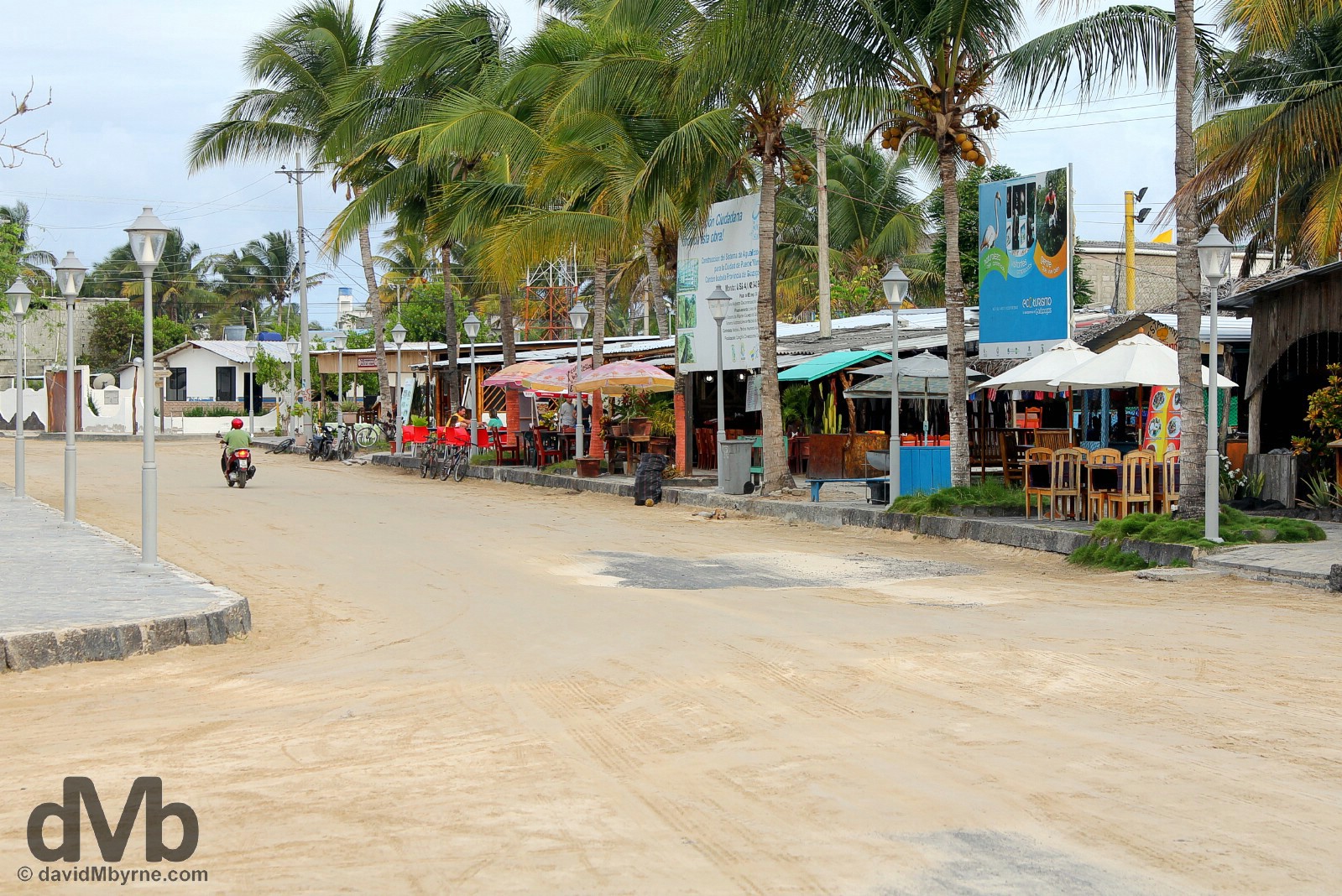
Av. Antonio Gil, the main drag in Puerto Villamil, Isla Isabela, Galapagos, Ecuador. July 20, 2015 || Home to a population of a little over 2,000, Puerto Villamil is the only settlement on Isla Isabala. Somewhere that doesn’t seem to have benefited from the vast sums of money Galapagos extracts from tourists, it’s a dusty, underdeveloped retreat that is nowhere near as big as Puerto Ayora on Isla Santa Cruz. Conversely, it draws nowhere near as many travellers. Sitting under the cloud-draped slopes of the huge Sierra Negra volcano, it was founded at the beginning of the nineteenth century and was named after Jose Villamil, the general who annexed the islands for Ecuador in 1832 and who would go on to become the first Governor of the Galapagos. Although only a little over 2 hours by ferry from Isla Santa Cruz, it’s still a somewhat off-the-beaten-track location & there’s really not a whole lot to do in the town itself. That said there’s plenty to see nearby making the town a convenient base.
One of the few attractions in Puerto Villamil itself is a bust of the island’s most famous visitor, Charles Darwin, located in the centre of the town lining its main drag Av. Antiono Gil.

A bust of Charles Darwin on display in the centre of Puerto Villamil on Isla Isabela, Galapagos, Ecuador. July 20, 2015.
Charles Darwin & His Theory of Evolution by Natural Selection
It was the Galapagos Islands that spurred English naturalist and geologist Charles Darwin (1809-1882) to formulate his ground-breaking theory of evolution by natural selection. It’s no stretch to claim that it was a discovery that had the effect of catapulting science – and the world – into the modern era. Darwin arrived at the Galapagos in September 1835 aboard the HMS Beagle as part of a wider expedition to chart the coasts of the South America continent. Darwin didn’t like the lay of the Galapagos land – “Nothing could be less inviting” he wrote – but nonetheless he spent 5 weeks collecting samples & observing the islands’ creatures; he was especially taken aback by their “tameness”, the result of them evolving in a predator-free environment. Observations made by Darwin on Galapagos, especially with regard to the island’s mockingbirds & finches, a.k.a. Darwin Finches, both unique to Galapagos, led him to speculate that the variant forms in each group had developed on the islands in different ways from an original species, what we now except as evolution by natural selection: those organisms best adapted to the environment in which they live will survive and reproduce. Darwin sat on his postulations for many, many years, somewhat afraid of the reaction they would receive. He eventually published his theory of evolution with compelling evidence in his groundbreaking 1859 book On the Origin of Species. By 1870 the scientific community and much of the general public had accepted evolution as a fact, just as we do today.
– Charles Darwin commenting on the Galapagos Islands in 1845
Here are a few images captured on this day during an enjoyable amble to the outskirts of Puerto Villamil.

A Marine Iguana recharging its batteries by basking in the sun on Playa Grande on the outskirts of Puerto Villamil, Isla Isabela, Galapagos, Ecuador. July 19, 2015.
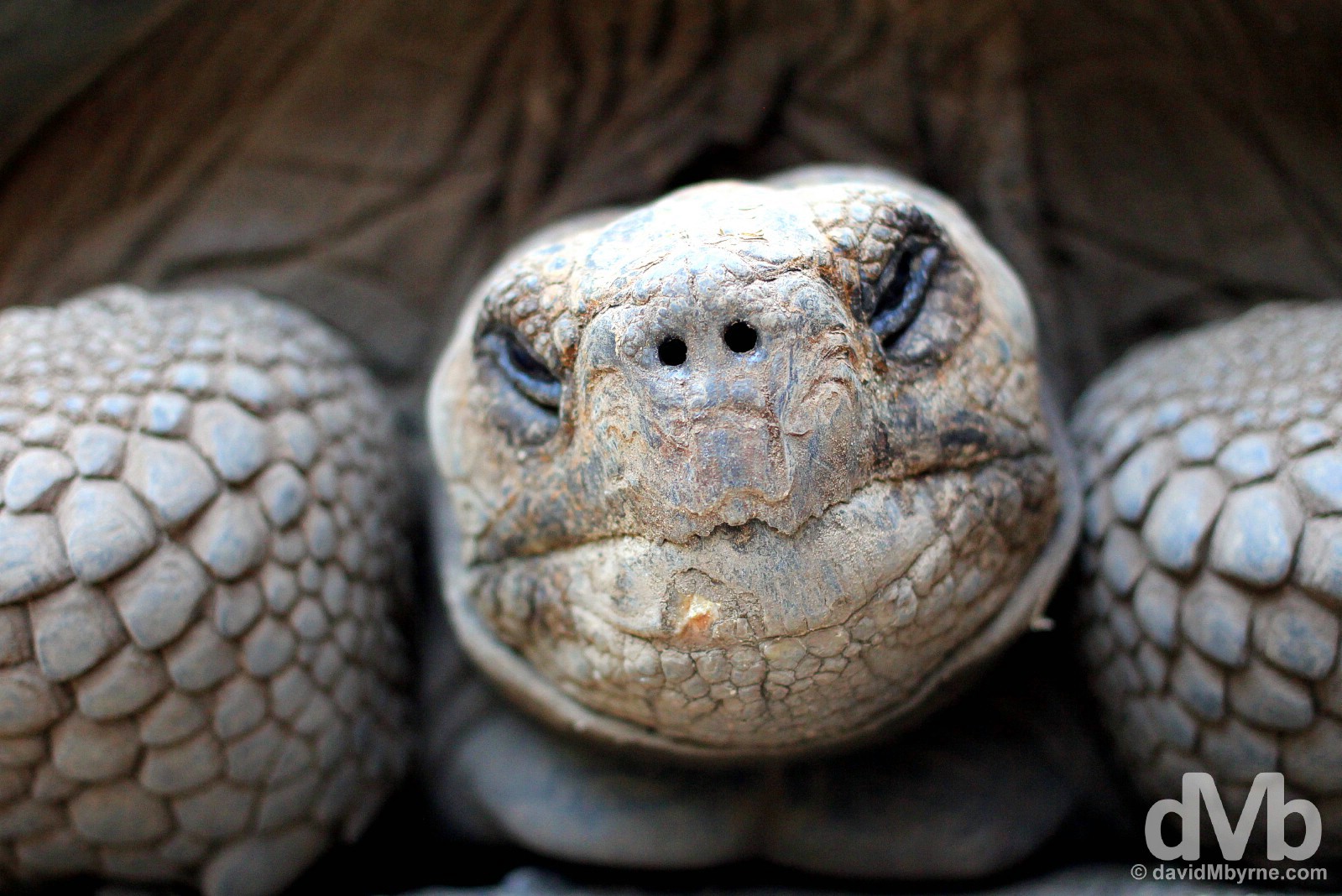
A resident tortoise in the Tortoise Breeding Centre on Isla Isabela, Galapagos, Ecuador. July 19, 2015 || Isla Isabela’s Tortoise Breeding Centre on the fringes of Puerto Villamil is accessed via a short walk through secluded brackish lagoons. Work is ongoing here to breed the five distinct species of Islbela tortoises, each based around the slopes of the largest five of the island’s 6 volcanoes – the interior of Isabela is so inaccessible that there exists 5 distinct subspecies of giant tortoise, the most on any Galapagos island.

Visitor Center of the Tortoise Breeding Centre on Isla Isabela, Galapagos, Ecuador. July 19, 2015.

Giant Tortoises in a pool in the Tortoise Breeding Centre on Isla Isabela, Galapagos, Ecuador. July 19, 2015 || It was late evening when I was snooping around and the breeeding centre was closed. Not that that mattered as the low-lying pens, including rearing pens for hatchlings and corals for adult tortoises rescued from the wild, are viewable by anyone during daylight hours.

A Flamingo in a pond on Isla Isabela, Galapagos, Ecuador. July 19, 2015 || Not far from the Tortoise Breeding Centre you’ll find Los Humedales, the Wetlands, an area of brackish lagoons and swamps that are criss-crossed by paths and elevated platforms.
Day Five
Date || July 20, 2015
Location || Puerto Villamil, Isla Isabela, Galapagos, Ecuador ( )
)
Our first choice was to ride horses to the summit of Isabela’s Sierra Negra (Black Mountain) but we eventually hoofed it there ourselves. And once we got there we kept on going through to the volcanic landscape of nearby Volcan Chico. It was a 6 hour, 16 kilometre wildlife-free ramble that kept us occupied for the bulk of Galapagos day 5, our last full day on the archipelago.
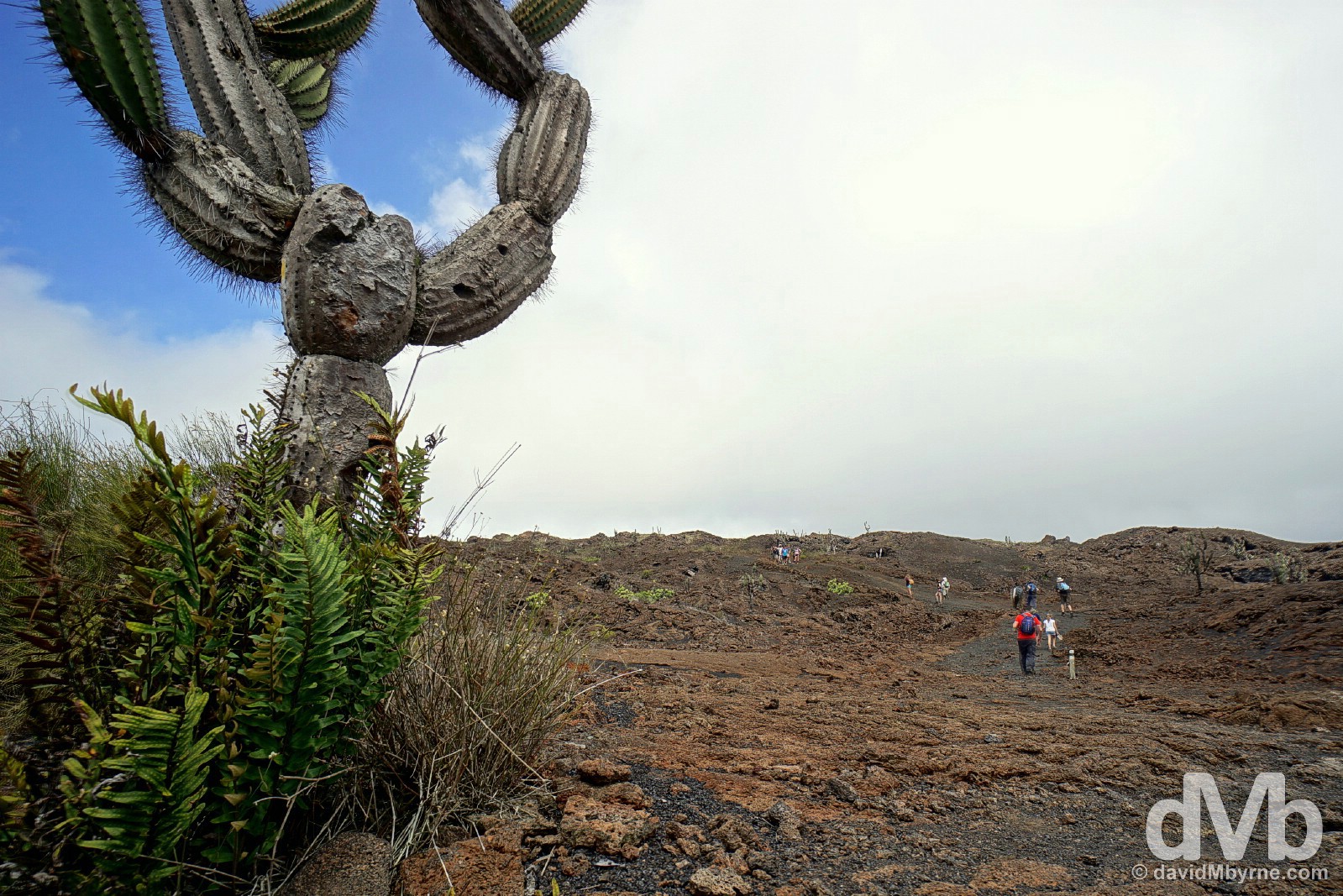
Volcanic topography on Volcan Chico, Isla Isabela, Galapagos Islands, Ecuador. July 20, 2015.
Sierra Negra & Volcan Chico
Sierra Negra is a large shield volcano. It is the oldest of Isabela’s six volcanoes and the closest of the six to Puerto Villamil, which rests on its southern slopes. One of the most active of the Galapagos volcanoes, its most recent eruption occurred in October 2005. Access to the rim of its massive caldera is via an uphill walk, one that must be undertaken in the presence of a guide. It’s not a particularly taxing walk (the volcano’s slopes have a shallow gradient) to the 1,124-metre-high caldera rim. Nor is it a particularly long walk, the end of which you’re treated to a rather impressive view over the massive caldera.
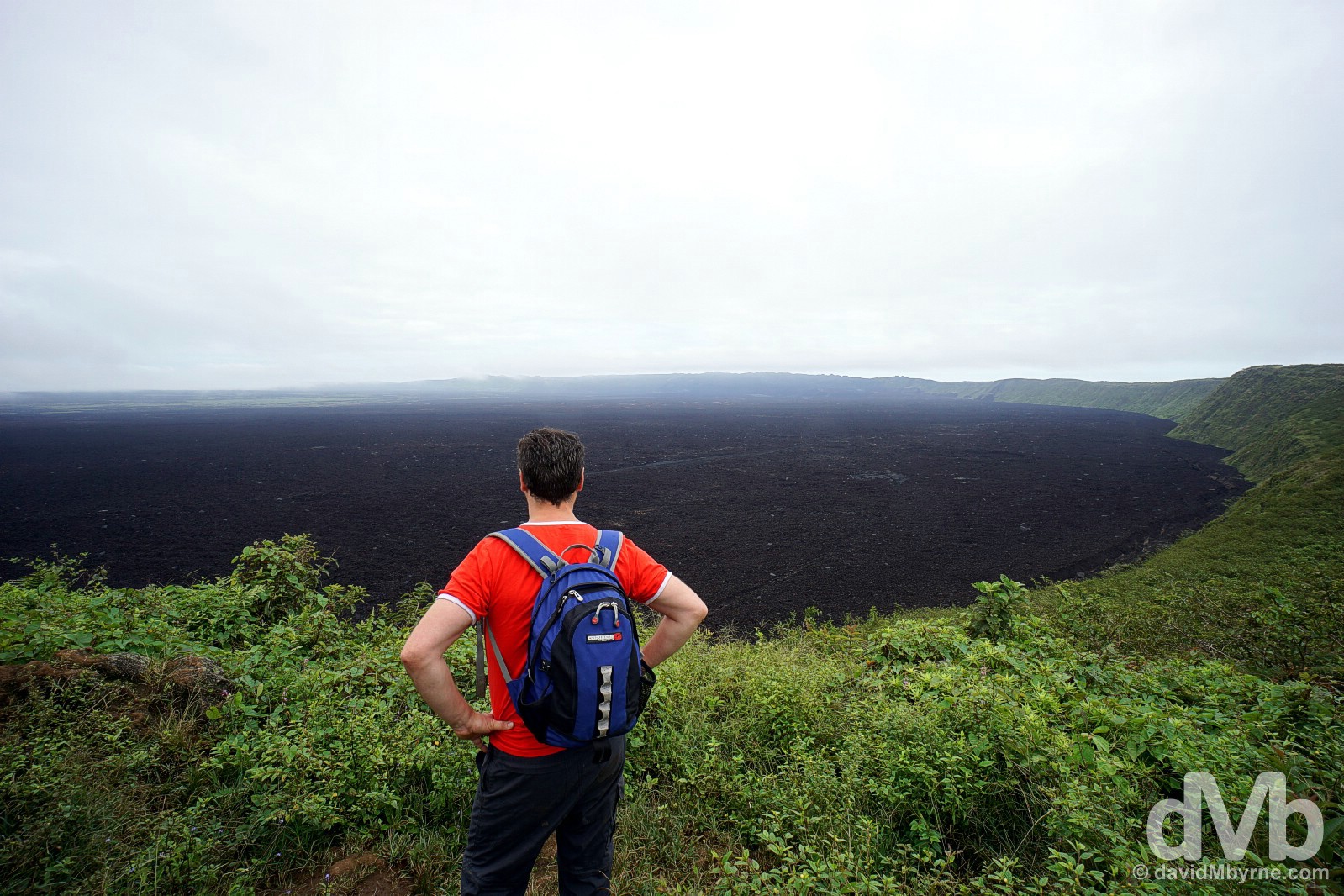
Overlooking the massive caldera of Sierra Negra on Isla Isabala, Galapagos, Ecuador. July 20, 2015 || The caldera of Siera Negra is a whopping 10 kilometres in diameter, easily the largest of all the Galapagos volcanoes. But at only 100 metres deep, it’s also the shallowest; it wouldn’t be a long scramble down to the caldera floor were you allowed to venture down there – you’re not.
Galapagos || Location & Formation
The Galapagos Islands are located on the equatorial line of the Pacific Ocean, 960 kilometres to the west of Continental Ecuador. The island’s 8,000 km² volcanic landmass consists of over 100 islets & rocks, 6 smaller islands & 13 major islands, only 5 of which – Isla Baltra, Isla Floreana, Isla Isabela, Isla San Cristobal and Isla Santa Cruz – are inhabited. The archipelago was formed from a volcanic hotspot located, at present, under the island of Ferandina at the extreme west of the archipelago. Sitting atop the Nazca Tectonic Plate, the islands are moving slowly but steadily to the east at a rate of 64 millimeters a year, meaning the islands to the east, closer to the Ecuadorian mainland, are the oldest, flattest & most eroded islands in the archipelago whereas the islands to the west, furthest from the mainland, are the higher, younger islands boasting active volcanoes. While the older islands have disappeared below the sea as they moved away from the mantle plume, the youngest islands, Isabela and Fernandina, are still being formed, with the most recent volcanic eruption in April 2009. Each island, which has a different set of unique species due to both isolation & variations in island age & topography, may exist for several million years before finally submerging beneath the sea.
Once at the rim of Siera Negra we kept going, traversing the eastern rim of the caldera before descending into the fresh lava fields north east of the main crater, the dusty, barren volcanic landscape of Volcan Chico.
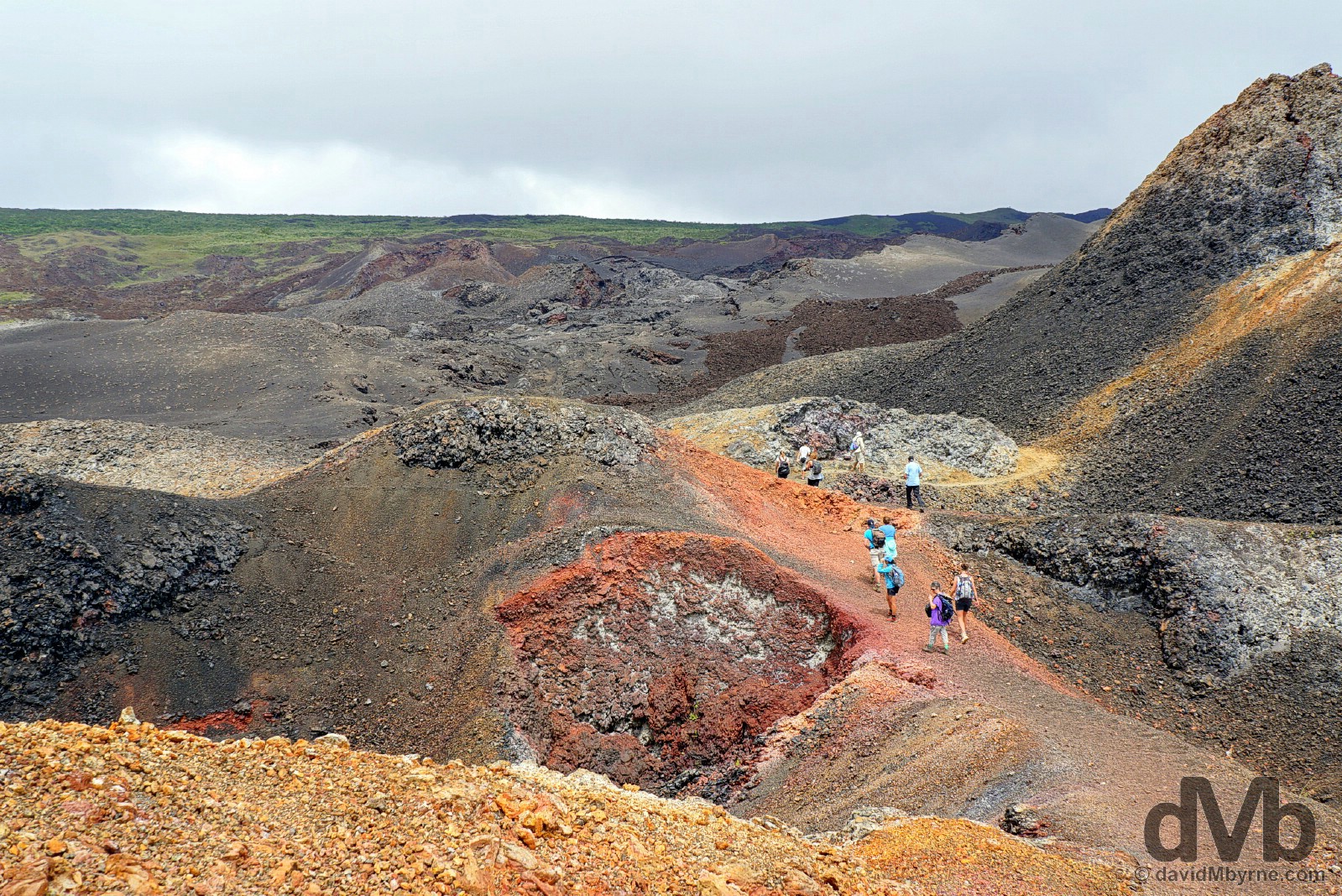
The multicoloured volcanic landscape of Volcan Chico on Isla Isabela, Galapagos, Ecuador. July 20, 2015.
In the late afternoon we got back to some semblance of normality, back to the wildlife, with a swim in Concha y Perla, a sheltered inlet surrounded by mangroves that’s popular with snorkellers & sea lions. And that was to be that from Galapagos.

A departing shot from Galapagos. Apparel on sale in Seymour Airport, Isla Baltra, Galapagos Islands, Ecuador. July 21, 2015.

